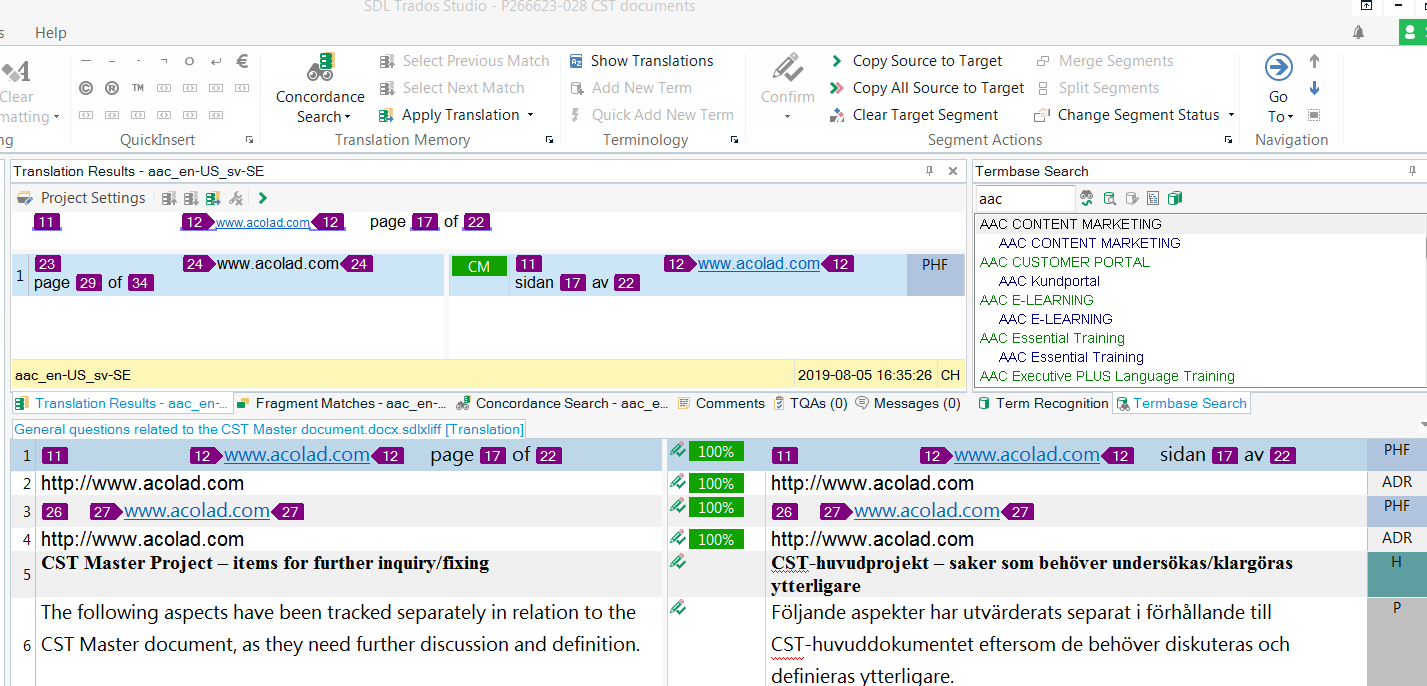
Did you know that you as a purchaser of language services can influence the quality of your translations?
Wouldn’t it be great to minimize the need for time-consuming questions and costly revision rounds? Save yourself some time and money by learning a few insider tricks about translation technology and localization from a senior language reviewer.
We have all experienced poor translations in one way or another, from errors in our favorite movie’s subtitles and typos in a familiar brand’s advertisements, to the bizarre use of terms and clumsy sentences in texts that look “obviously translated” from the get-go.
But even if a translation is not linguistically incorrect, there are many things that can go wrong during the translation process. Each company, client or even person has individual preferences regarding style, tone of voice and terminology.
On top of all this, the language quality must be perfect, every little fact correct, and ideally the translation should even sound better than the original. It seems that even very dry technical descriptions should somehow sound more fun in the target language…
As you can see, there are many factors that can affect translation quality. To help out in this respect, we want to let you in on the most important ones so that you can improve the quality of your own translations:
- Planning ahead
- Quality of the source text
- Subject matter expertise
- Context and instructions
- Reference material
- SEO aspect
- Style guide and creative brief
- Translation memories, termbases and glossaries
- Validation and feedback
- Long-term relationship with a professional vendor
As simple as these tips they may seem, they will make a world of difference for the quality of your translations.
1. Planning ahead
You can form the basis for a good translation by planning ahead for the translation and by allowing enough time for the translation process.
If you need a last minute translation of an extensive amount of material, this can probably be arranged, but your translation provider might need to divide the assignment among several translators to meet the deadline.
And the translators will be forced to work in a rush, which can affect the quality negatively. Using several translators can potentially result in inconsistent translations due to the different terminology and styles used by the various translators.
2. Quality of the source text
The translation or localization will be based on your source text, so make sure you are happy with it before sending it to be translated.
Any errors, omissions, inconsistent terminology or vague wording can affect the translation quality. You might end up with time-consuming questions that you need to answer, or a translation that contains exactly the same problems as the source text.
Therefore, it is important for the source text to be written in a way that the translator can fully understand without having to guess what anything means. Sending questions and waiting for answers eats up valuable time in the translation process.
3. Subject matter expertise
To ensure the best quality, translation assignments should be assigned to a translator or translation agency that is familiar with your particular subject matter or text type.
If the translator lacks experience within a particular subject area, the end result may not live up to your standards. The translator also needs to know which sources are most suitable for researching terminology within the area. For instance, a translator specialized in medical texts would not know the specific terms and concepts that are common in legal translations.
Translators generally provide information about their specific areas of expertise, and do not take on assignments that are outside the scope of that expertise. Translation agencies generally use tried and tested translators within the different subject areas, which adds an extra level of reliability.
4. Context and instructions
It is very helpful if you can provide some context for the texts to be translated and localized. What is the purpose of the text, and where will it be used? Context can also be provided on a more detailed level, in order to prevent misinterpretations and other errors.
Sending even a short text to be translated without context or information about where it is going to be used can lead to inconsistencies. For instance, if the translator only receives a few sentences with technical instructions that do not include the name of the product or end customer, it can be difficult to translate the terminology correctly.
It is also good to remember that the shorter the text, the more difficult it is for your service provider to do research online about the product or company. So be sure to brief your service provider on where you are going to use the material when you order language services.
5. Reference material
Translators will use any reference material or glossaries that you can provide. They generally also need to perform online research; for example, the localized versions of a company’s website can provide valuable information regarding terms, names of products and services and communication style.
The translator may be able to use reference materials such as a website or other content that has already been translated into the target language in other ways as well. For example, if a term is inconsistent in the translation memory, the translator can check which option is used on the website to see which option is preferred.

6. SEO aspect
Ninety-three percent of online experiences begin with a search engine*. That is why online marketing content these days should always be adapted for search engine optimization, SEO. You need to ensure your content is found by search engines and shows up in the search results of your potential clients.
Since SEO work starts at source text level, your original needs to include SEO keywords that are relevant and used to find your company, and that drive traffic to the content. To ensure that your translation performs as well as the original, it is a good idea to define the SEO optimized terms in the target languages. This is something that multilingual SEO (also called international SEO) addresses.
If you have marketing content that needs to be translated, it is a good idea to discuss SEO with your translation vendor and to define the terminology for each target language before translation begins. You can read more about multilingual SEO here. Find more general information about SEO here and here.
* Source: imFORZA
7. Style guide and creative brief
If your company has specific guidelines regarding style and tone of voice, it is helpful to specify them in a style guide. The style guide should be as brief as possible and not contain general linguistic or grammar rules, but rather only company-specific information such as:
- Which language variant should be used (for example, US/UK)?
- Is there a defined tone of voice?
- Should specific terminology or SEO optimized terms be used?
- Should a specific style be used?
Remember to keep the style guide as brief as possible.
If applicable, you can also produce a creative brief for the project that determines the framework for the material to be produced, including target audience, goal of the campaign, tone of voice, etc. Read this blog if you want to learn more about what a brief should contain.
8. Translation memories, termbases and glossaries
Incorrect terminology usage is one of the most common issues clients face in their translations.* If you as a client go through and correct your translations and send them back to your vendor as feedback, the changes can be entered into the translation memory (a database that contains all of your translations). This allows your translation service provider to use the correct terminology in subsequent assignments more automatically.
Feedback on terminology should also be entered into a termbase or glossary as another means to ensure the correct terminology is used in future projects. To make this happen, ask for a term base! Your feedback can be used to maintain both termbases and translation memories and to update terms and specific phrases.
Below you can see an example view of a termbase and translation memory:

As the translators learn more about your preferences, they will try to use your preferred terminology. This leads to fewer changes in the resulting translations, which means less work for you. Consequently, you can save both time and money by providing more feedback in the initial phase of projects. Read our reference case on ABB’s TermBANK and how ABB works with terminology.
* Source: Acolad
9. Validation and feedback
Let your vendor know what you think about the translation services – good AND bad – and be as specific and precise as possible. In order to find the right tone of voice and to make sure the correct terminology is used, it is very beneficial for the end result if you as the client provide feedback on the language services. If you provide feedback, the translation vendor will have a better chance to translate the texts to your liking next time.
For some clients, validation is an integral part of the translation process for all of their assignments, and validation is performed on an ongoing basis. This basically means that the client reviews and approves all of the translations before they are considered final. See one example of this in our reference case on Esri which addresses the importance of validation and continuous improvement.
In some companies, the validation step is only added for strategic documentation like annual reports and financial statements, or for technical information. In general, it is a very good idea to include a validation step for new clients, since this presents an opportunity to get things right from the start. If you want to obtain the best translations possible for your company, adding the validation process can be an important step.
10. Long-term relationship with a professional vendor
Most translation agencies and freelance translators use tools for terminology management, translation and localization. Vendors may use technology to improve the translation process and various quality checks to ensure that all of the translations and terms are collected and safeguarded for the next assignment.
As there are several aspects that affect translation quality, good cooperation and communication with your service provider is essential. A long-term relationship enables translation memories which contain all of your translations to be built up and maintained over time for the various languages. In the same way, the translation agency can create a termbase or glossary where new terms can continuously be added over time as well.


